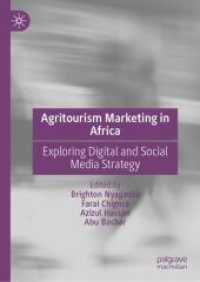- ホーム
- > 洋書
- > 英文書
- > Science / Mathematics
Full Description
This volume comprehensively reviews recent advances in our understanding of the diversity of microbes in various types of terrestrial ecosystems, such as caves, deserts and cultivated fields. It is written by leading experts, and highlights the culturable microbes identified using conventional approaches, as well as non-culturable ones unveiled with metagenomic and microbiomic approaches. It discusses the role of microbes in ecosystem sustainability and their potential biotechnological applications. The book further discusses the diversity and utility of ectomycorrhizal and entomopathogenic fungi and yeasts that dwell on grapes, it examines the biotechnological applications of specific microbes such as lichens, xylan- and cellulose-saccharifying bacteria and archaea, chitinolytic bacteria, methanogenic archaea and pathogenic yeasts.
Contents
Part 1. Soil and Agroecosystem.- Chapter 1. Cave microbiome for human welfare.- Chapter 2. 2. Diversity of nitrogen fixing symbiotic rhizobia with special reference to Indian Thar Desert.- Chapter 3. Soil microbiota and sustainable Jhum agroecosystem.- Chapter 4. Diversity in Type III secreting systems (T3SS) in Legume-Rhizobial symbiosis.- Chapter 5. Microbe based novel biostimulants for sustainable crop production.- Chapter 6. Ectomycorrhizal diversity and tree sustainability.- Chapter 7. Diversity of AM fungi in relation to sustainable plant production systems.- Chapter 8. Microbial diversity on grapes and other fruits: Role and significance in fermentation.- Chapter 9. Harnessing entomopathogenic fungi for enhanced farm productivity and profitability.- Chapter 10. Bioactive molecules obtained from microbes of the Sundarbans.- Chapter 11. Microbiome engineering in rhizosphere: Potential in improving food security.- Chapter 12. Dynamics of plant-microbiome and its effect on the plant traits.- Part 2. Diversity of Specific microbial Groups.- Chapter 13. Phylogenetic diversity of lichen photobionts, its coevolution with mycobionts, and potential bioprospects.- Chapter 14. Diversity in xylan-degrading prokaryotes and their bioprospects.- Chapter 15. Diversity in cellulose degrading microbes and their cellulases: role in ecosystem sustainability and potential applications.- Chapter 16. New paradigm in degradation of lignocellulosic biomass and discovery of novel microbial strains.- Chapter 17. Secondary metabolism in Trichoderma- chemical and genomic diversity.- Chapter 18. Diversity of chitinase producing bacteria and their possible role in plant pest control.- Chapter 19. Diversity in endophytic microbes and their bioactive compounds.- Chapter 20. Wild edible mushroom of North West Himalaya - their nutritional, neutraceutical and sociobiological Aspects.- Chapter 21. Methanogens for humanwelfare: more boon than bane.- Chapter 22. Genetic diversity in pathogenic yeasts.








